Gallery: The infrared universe seen by NASA's Spitzer Space Telescope
NASA's Spitzer Space Telescope launched in 2003 on a mission to study the universe in the infrared. Its mission will come to an end on Jan. 30, 2020, after 16 years of amazing images and scientific discoveries. Check out some of our favorite Spitzer images here.
Related: It's time to say goodbye to the Spitzer Space Telescope. Here's why.
Helix Nebula
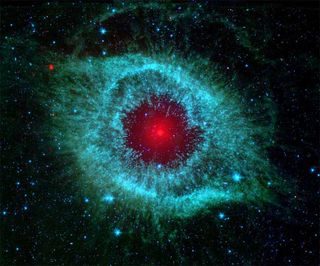
This infrared image from NASA's Spitzer Space Telescope in 2007 shows the Helix nebula, a cosmic starlet often photographed by amateur astronomers for its vivid colors and eerie resemblance to a giant eye.
Related: Giant Eye In Space Seen by NASA Telescopes
Supernova Remnant HGH 3
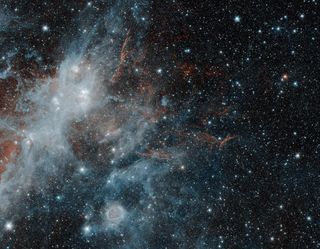
This supernova remnant, known as HBH 3, is one of the largest in the Milky Way galaxy and measures about 150 light-years across. It is also one of the oldest; the star that exploded to create this cosmic spectacle did so 80,000 to 1 million years ago. Spitzer captured this image in May 2010, and NASA released it on Aug. 2, 2018.
Full Story: Ghostly Remains of a Dead Star Revealed in Infrared Light (Photo)
Penguin and Egg Galaxies
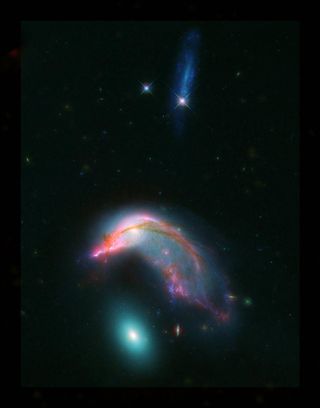
The galaxies NGC 2336 and NGC 2937 look like a penguin and its egg, respectively, in this photo, which incorporates data from NASA's Hubble and Spitzer space telescopes.
Get the Space.com Newsletter
Breaking space news, the latest updates on rocket launches, skywatching events and more!
Full Story: Galaxy Duo Looks Just Like a Penguin Guarding Its Egg (Photo)
The Sombrero Galaxy
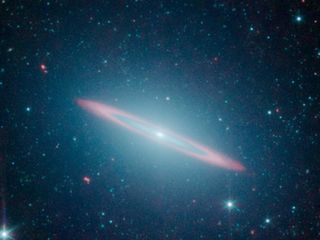
The infrared vision of NASA's Spitzer Space Telescope has revealed that the Sombrero galaxy — named after its appearance in visible light to a wide-brimmed hat — is in fact two galaxies in one. It is a large elliptical galaxy (blue-green) with a thin disk galaxy (partly seen in red) embedded within. Previous visible-light images led astronomers to believe the Sombrero was simply a regular flat disk galaxy.
Full Story: Famous Sombrero Galaxy Shows Surprising Side
Carina Nebula

Massive stars can wreak havoc on their surroundings, as can be seen in this new view of the Carina nebula from NASA's Spitzer Space Telescope. The bright star at the center of the nebula is Eta Carinae, one of the most massive stars in the galaxy. Its blinding glare is sculpting and destroying the surrounding nebula.
Related: Carina Nebula: Amazing Photos of a Colorful Cosmic Cloud
The Cat's Paw Nebula

NASA's Spitzer Space Telescope captured this view of the Cat's Paw Nebula in 2018. The nebula gets its name from the bubbles of hot gas it contains that — if you squint a bit — resemble feline paw pads.
Full Story: Picture Purrrrrfect! NASA Snaps Photo of Cat's Paw Nebula
Dumbbell Nebula

The Dumbbell Nebula, also known as Messier 27, pumps out infrared light in this image from NASA's Spitzer Space Telescope. The nebula was named after its resemblance to a dumbbell as seen in visible light. It was discovered in 1764 by Charles Messier, who included it as the 27th member of his famous catalog of nebulous objects.
Related: Weighing in on the Dumbbell Nebula (Space Wallpaper)
Cepheus Stars and Green Nebulas
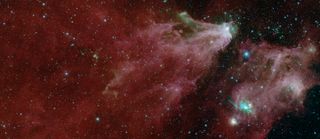
Because of its infrared sensitivity, Spitzer can get a stunning look at nebulas, the clouds of dust and gas peppered throughout the universe. The puffy green structures in the image above, released in 2019, are nebulas, with stars scattered within them, including a cluster called Cepheus C on the left and one called Cepheus B in the upper right corner.
Video: Cepheus Stars Observed by Spitzer Space Telescope
Full Story: With End in Sight, Spitzer Space Telescope Releases Glorious Nebula Images
Orion Unveiled

This infrared image from NASA's Spitzer Space Telescope shows the Orion nebula, the closest massive star-making factory to Earth.
Related: The Splendor of the Orion Nebula (Photos)
Green Nebula Ring

A glowing ring spotted in space seems at first more like superhero fiction than science fact. But that's what NASA's Spitzer Space Telescope found in the murky clouds encircled by the tail of the constellation Scorpius. This photo of the bright emerald nebula, released in 2011, is reminiscent of the glowing ring wielded by the comic book superhero Green Lantern
Full Story: 'Green Lantern's Ring' Shines in NASA Space Photo
Spiral Galaxy Spider Web

Looking like a spider's web swirled into a spiral, the galaxy IC 342 presents its delicate pattern of dust in this image captured by NASA's Spitzer Space Telescope in 2011. Seen in infrared light, the faint starlight gives way to the glowing bright patterns of dust found throughout the galaxy's disk.
Full Story: Spiral Galaxy Glows Like a Cosmic Spider Web

Join our Space Forums to keep talking space on the latest missions, night sky and more! And if you have a news tip, correction or comment, let us know at: community@space.com.

Space.com is the premier source of space exploration, innovation and astronomy news, chronicling (and celebrating) humanity's ongoing expansion across the final frontier. Originally founded in 1999, Space.com is, and always has been, the passion of writers and editors who are space fans and also trained journalists. Our current news team consists of Editor-in-Chief Tariq Malik; Editor Hanneke Weitering, Senior Space Writer Mike Wall; Senior Writer Meghan Bartels; Senior Writer Chelsea Gohd, Senior Writer Tereza Pultarova and Staff Writer Alexander Cox, focusing on e-commerce. Senior Producer Steve Spaleta oversees our space videos, with Diana Whitcroft as our Social Media Editor.
